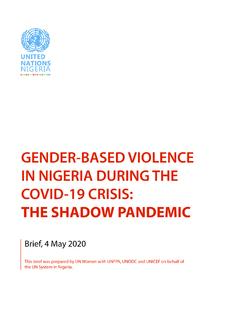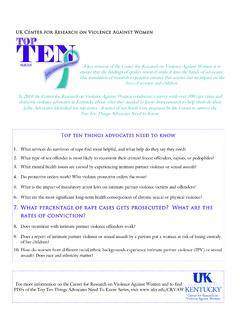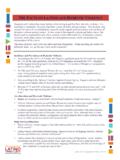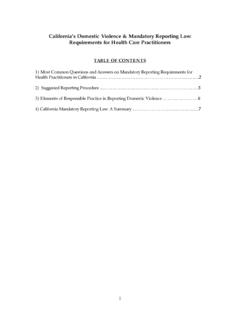Transcription of A Sociologist’s Perspective on Domestic Violence: A ...
1 A Sociologist s Perspective on Domestic violence : A Conversation with Michael Johnson, Interview by Theodora Ooms, CLASP From the May 2006 conference sponsored by CLASP and NCSL: Building Bridges: Marriage, Fatherhood, and Domestic violence Center for Law and Social Policy 2006 2 2 Intro (Ooms): Michael, you describe yourself as a sociologist, a feminist and Domestic violence advocate. For over three decades you have been on the faculty of The Pennsylvania State University conducting research and teaching courses on Domestic violence , women s studies and African American studies.
2 You have also been actively involved in supporting your local Domestic violence program. Q. How did you first become interested in the issue of Domestic violence ? A. I became an active feminist in the 1960s, when violence against women was one major focus of our activism because rape and Domestic violence were still being treated as personal rather than social problems. violence against women has been a major focus of my women s studies courses since I began teaching in the early 1970s. Domestic violence became the major focus of my research much later, when I joined a group of feminist family scholars on a trip to Vietnam in 1993 in which our goal was to offer information that would help the Vietnamese government to address a variety of women s issues, including Domestic violence .
3 Q. The Domestic violence movement is around three decades old and has accomplished much in increasing public awareness, in getting protective laws enacted and creating an extensive network of services around the country. Traditionally, how has the movement defined and described the term Domestic violence ? A. Well, the standard definition of Domestic violence in the battered women s movement has been what I call intimate terrorism, the kind of violence in which men control their women using a variety of coercive control tactics, including physical and sexual violence . Virtually every women s shelter and feminist Domestic violence program around the country uses the Power and Control Wheel (see diagram) to describe and define Domestic violence as a pattern of violent coercive control in which the coercive partner makes use of violence in combination with variety of other tactics such as psychological or economic abuse to take virtually complete control over his partner.
4 Q. Meanwhile, in academia there has been what you have called a sometimes acrimonious debate about the gender symmetry of Domestic violence . Can you explain what this debate is about? A. To put the argument very simply, it has to do with whether there are as many battered husbands as there are battered wives. One group argues that women are as likely to be violent as are men in intimate relationships, the other that Domestic violence is perpetrated almost entirely by men. The reason the argument has lasted so long is that each group has been able to provide credible research evidence for its position.
5 The reason the debate has been so acrimonious is that the gender symmetry position has sometimes been used as an attack on feminism in general, and on the battered women s movement in particular. To those in the battered women s movement this attack is seen to put battered women s lives at risk, and emotions can run very high. Q. You have published extensively on Domestic violence , and within the last decade you have explained that the seemingly contradictory research findings regarding gender can be reconciled by recognizing both that there is more than one kind of violence in intimate relationships and that the major sources of data on Domestic violence tap different kinds of violence .
6 Can you briefly Center for Law and Social Policy 2006 3 3describe the three main types of intimate partner violence , and which are the most prevalent? Situational couple violence is the most common form of intimate partner violence . It is the sort of violence that enters a relationship when a disagreement that turns into an angry argument escalates into violence . The violence can be mild or severe, and although often this is an isolated incident in a relationship, some couples have a recurring pattern of such violence that is extremely dangerous. Although this type of violence is almost as likely to be perpetrated by women as by men, men do more serious damage and their violence is more likely to introduce fear into a relationship and to get the authorities involved.
7 Intimate terrorism is the kind of intimate partner violence that involves a batterer who terrorizes and takes complete control of his partner through the use of violence in combination with other control tactics such as threats and intimidation, economic control, psychological abuse, isolation, and the assertion of male privilege. In heterosexual relationships, intimate terrorism almost always involves a man terrorizing a woman, although in rare cases men are terrorized by their women partners. Although intimate terrorism is much less frequent than is situational couple violence , it is estimated that more than two million women are victims of this kind of abuse in the United States each year and this is the intimate violence that is most likely to destroy lives.
8 Violent resistance is the violence involved when a victim of intimate terrorism fights back. This is the violence of women trying to physically resist domination by abusive men. It is often transitory because of men s usual ability to dominate a woman physically, and most women who resist violently soon turn to other means of coping with their abuse. Just so there s no misunderstanding, let me add that all three types of violence can be dangerous, even life-threatening, and some sort of intervention is called for in each type of intimate partner violence . Q. Can you explain how the biases of the major sources of data about Domestic violence have produced misunderstandings about the role of gender?
9 A. There are two major sources of data about Domestic violence . The first is public agencies such as the police, the courts, hospitals, and shelters. Those data are dominated by intimate terrorism and violent resistance because intimate terrorism is much more likely than situational couple violence to produce the fear that leads victims to turn to such agencies for help, the injuries that require help from the health system, or the call from friends and neighbors for intervention. Thus, researchers who work with such agency data see violence that is primarily male in perpetration. The second major source of data is so-called random sample surveys that claim to be much more representative of reality than agency data.
10 Researchers who use these data often argue that agency data are biased but survey data are not. What is little known to the public is that survey data also have a major source of bias in non-response. Although such surveys start with representative samples, many of the people contacted actually refuse to participate 40% refuse in the major family violence surveys. Of course, the 40% who refuse includes almost all of the intimate terrorists and their victims, the former to protect themselves from outsiders, the latter to protect themselves from their abusers who would be likely Center for Law and Social Policy 2006 4 4to attack them for telling their story to researchers studying family life.















